Top 5 Quote-to-Cash Software Platforms for B2B SaaS in 2025 (Ranked by Revenue Impact)
The Challenge: You’re evaluating quote-to-cash software—but do you really need more automation, or more cash in the bank?
Most Q2C platforms promise speed: faster quoting, cleaner workflows, automated approvals. But here’s the real bottleneck in SaaS today—not quoting velocity, but cash velocity.
A 2024 survey found that 93% of high-growth SaaS companies lose more than 10% of ARR to payment delays, defaults, and post-signature friction. The culprit? Q2C systems that automate the process—but don’t solve the payout.
So ask yourself:
❌ Do you need another quoting tool?
❌ Or do you need to stop chasing cash after "Closed Won"?
You’ve seen the signs in our earlier breakdowns of broken Q2C workflows and the true cost of delayed cash flow.
👉 This post reviews five quote-to-cash software, but not the usual suspects hyped for automation alone. These are ranked by revenue impact: how well they accelerate closes, protect ACV, and get cash in hand fast.
🔍 What to Look For in Quote-to-Cash Software (If Really Care About Your Cash Flow)
Most Q2C platforms promise quoting accuracy, workflow automation, and billing integration. And that’s a great start.
But if you're buying quote-to-cash software in 2025, you’re probably not just solving for the process. You’re solving for pipeline velocity, pricing protection, and, most importantly, faster cash in the bank. After all, cash is king, right?
That’s why we built this checklist: to evaluate Q2C solutions not just by features, but by revenue impact.
Use this to cut through the noise and identify which software is built to help your SaaS company close faster, protect ACV, and collect full payment sooner.
✅ Accelerated Cash Collection
- Ask your vendor: Does the platform help you get paid upfront—or just record bookings?
- Why it matters: “Closed Won” isn’t enough if you’re still chasing cash 90 days later.
✅ Flexible Payment Terms Without Margin Loss
- Ask your vendor: Can Sales offer monthly or deferred terms without approval delays or discount pressure?
- Why it matters: Buyers expect flexibility. Your team shouldn’t sacrifice cash flow to give it.
✅ Embedded Financing, Built for SaaS
- Ask your vendor: Does it include non-dilutive, off-balance-sheet financing that works with ARR and contract terms?
- Why it matters: Most Q2C platforms stop at invoicing. Few solve for seller cash flow.
✅ Risk-Based Deal Structuring
- Ask your vendor: Can it tailor terms in real time based on a buyer’s credit profile—without manual underwriting?
- Why it matters: A one-size-fits-all deal desk slows good deals and increases risk on weak ones.
✅ Collections Offload
- Ask your vendor: Who owns repayment reminders, follow-ups, and dunning workflows—you or the platform?
- Why it matters: Collections is not a good use of your Sales or Finance team’s time.
✅ Unified Visibility for Sales, Finance & RevOps
- Ask your vendor: Can all teams track quote status, approvals, payment timing, and risk in one place?
- Why it matters: Misalignment delays deals. Shared visibility closes them faster.
✅ Seamless Integration with Your Existing Stack
- Ask your vendor: Does it plug into Salesforce, HubSpot, CPQ, ERP, and billing—without expensive rebuilds?
- Why it matters: The best Q2C software accelerates what you already do, not replaces it.
✅ Scalable for $5M → $500M+ ARR Growth
- Ask your vendor: Can it support growing deal volume, complex renewals, hybrid pricing, and multi-entity billing?
- Why it matters: What works at Series A often breaks at Series C. Choose software that scales with you.
This is the exact lens we used to evaluate the five quote-to-cash software below—ranked not by brand hype, but by revenue impact.
👇 Let’s get into the rankings.
🏆 5 Quote-to-Cash Software for B2B SaaS — Ranked by Revenue Impact
We analyzed five leading quote-to-cash platforms through one lens: how much they move the revenue needle for SaaS companies.
These tools go beyond quoting and automation. They help sellers close faster, offer flexible terms without sacrificing margin, and accelerate actual cash collection.
Here’s who made the list:
- Ratio Boost
- – Revenue-first Q2C with embedded financing and upfront seller payouts
- Cacheflow – Checkout-style quoting and payment flows tailored for SaaS
- DealHub QTC – Unified quoting, contracts, and billing to streamline complex deals
- Maxio CPQ – SaaS-native Q2C stack with deep billing and revenue recognition
- Salesbricks – Lightweight, flexible Q2C for lean or PLG-driven teams
Let’s get into each one by one and see what impact they actually bring to your revenue 👇
1. Ratio Boost – The Only Quote-to-Cash Software with Embedded Financing for B2B SaaS
Most quote-to-cash (Q2C) platforms automate quoting and billing—but stop short of solving the most critical piece of the sales cycle: getting paid.
We break this down in our post on the missing piece in your SaaS Q2C process—and how to fix it.
What good is a streamlined quote if you’re still waiting 60-90 days to see the cash?
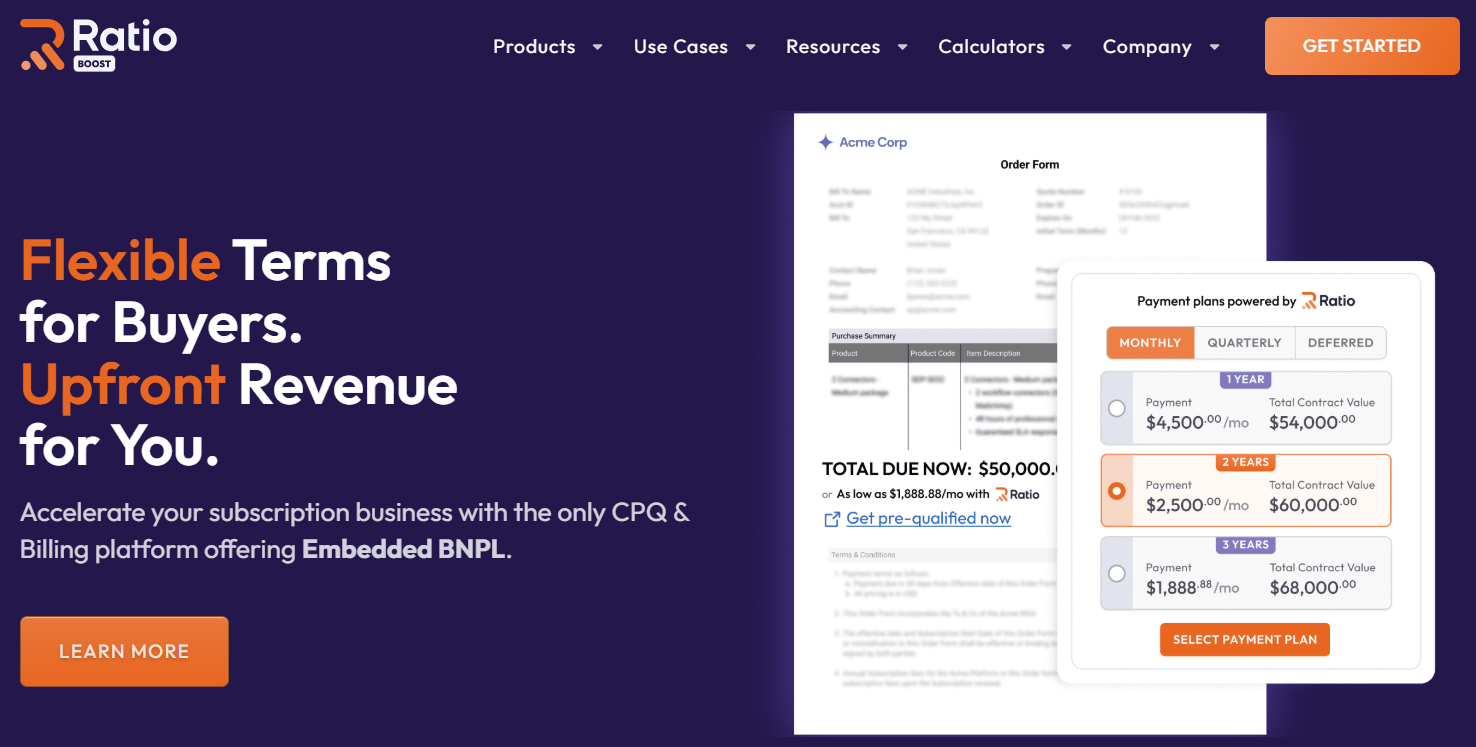
Ratio Boost fills that gap by embedding vendor-side financing directly into the quoting workflow. So when your rep sends a quote:
- The buyer sees flexible payment options—monthly, quarterly, deferred, or custom terms
- The seller (you) gets paid the full contract value upfront
- Ratio takes on the credit risk and collects from the buyer over time
This transforms Q2C from a workflow tool into a true revenue engine.
🏆 Why It Ranks #1 for Revenue Impact
Unlike traditional Q2C tools that optimize operations, Ratio Boost optimizes cash.
It shortens time-to-cash, preserves ACV without deep discounts, and eliminates the need for collections—while still giving buyers the flexibility they expect.
That’s what makes it the highest-impact Q2C solution for revenue outcomes in 2025.
💡 Real-World Impact: DearDoc
DearDoc, a fast-scaling healthtech company, used Ratio Boost and experienced:
- Reduced financing approval times from days to under 45 minutes
- Increased conversion rates by 20–30%
- Consolidated quoting, contracting, and collections into a single platform
“Ratio Boost helped us consolidate quoting, contracting, payment, and collections into a single flow—and close faster as a result.”
— Joe Brown, CEO, DearDoc
And they’re not alone.
In 2025, Ratio reported over 800% YoY growth driven by SaaS companies choosing a Q2C model that delivers cash, not just automation.
Taxwell (also known as Drake Software) adopted Ratio to align with SMB buyers' cash flow, eliminate approval delays, and unify sales and finance workflows—without needing a separate CPQ system.
👉 You might also be interested in How CPQ with Embedded Financing Fuels SaaS Growth.
🚀 Ratio Key Features That Move Revenue
- 🔌 Embedded BNPL in Quotes: Offer net-30, monthly, quarterly, deferred, or custom payment options—while still collecting the full contract value upfront. Buyers get flexibility. You get cash, fast.
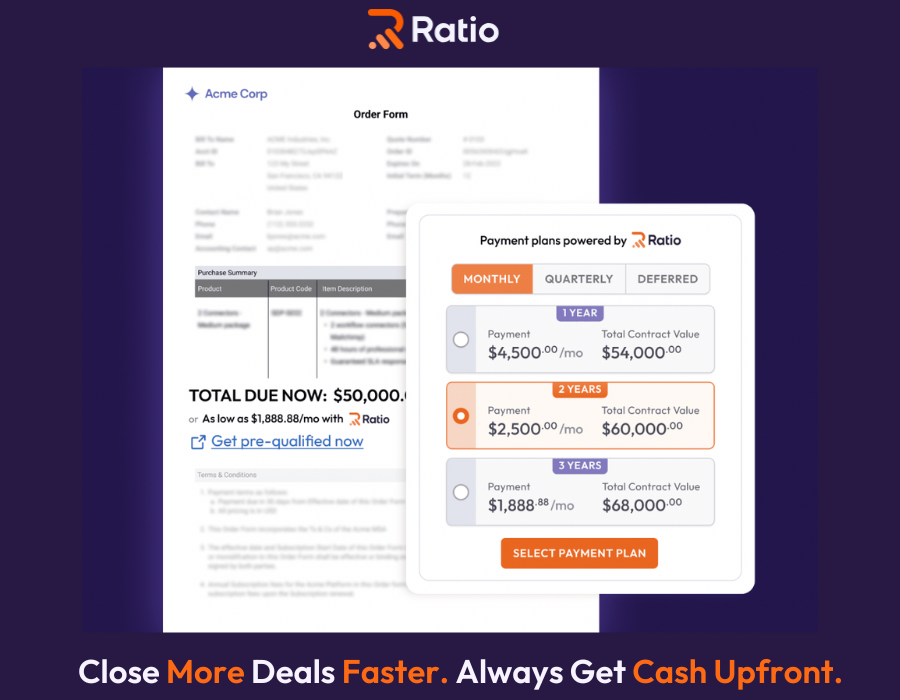
- ⚡ Real-Time Risk-Based Underwriting: Ratio dynamically evaluates buyer risk and pre-approves ~87% of deals in under a second—eliminating delays, friction, and sales drop-off.

- 💸 Day-1 Upfront Payout to Sellers: You receive the full contract value (minus a small fee) on Day 1. Ratio assumes the credit risk and handles repayment, freeing your team from collections.
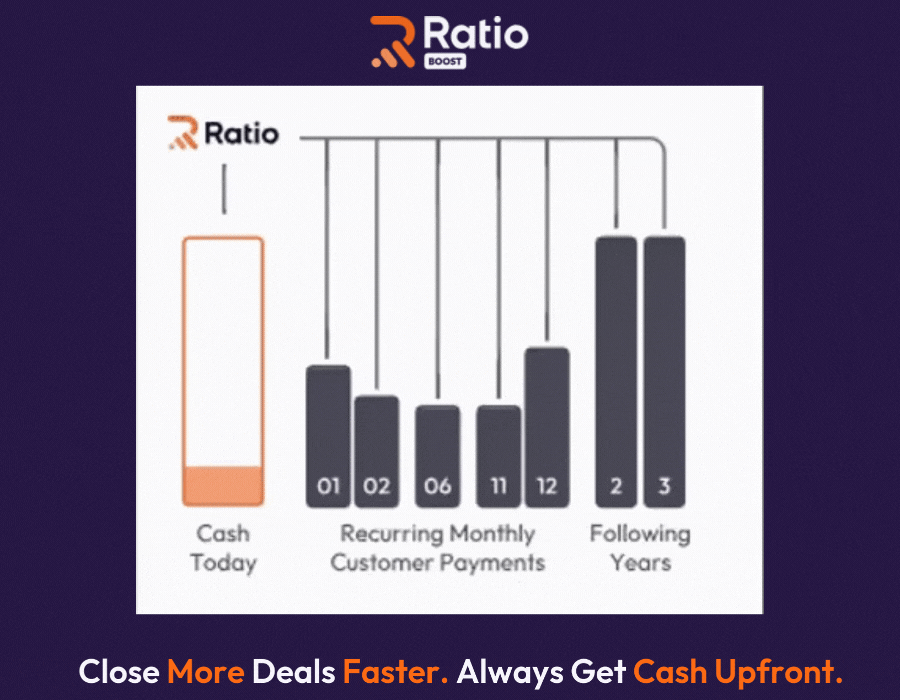
- 🤖 Deal Structuring Intelligence: Ratio recommends optimal payment terms and pricing strategies based on buyer risk and intent—helping reps preserve ACV and close faster, without over-discounting.
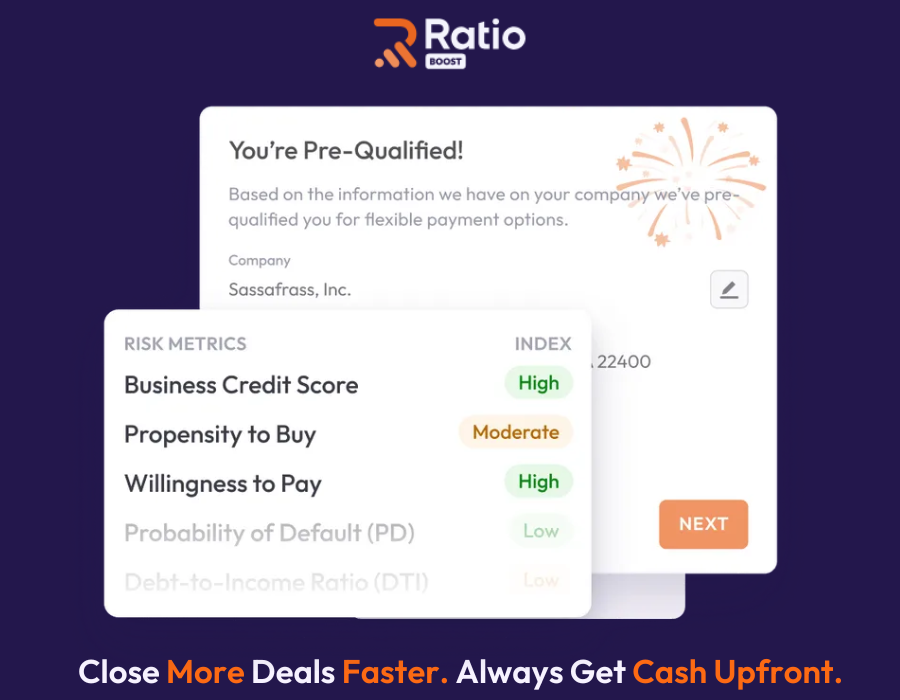
- 📊 Checkout-Level Deal Tracking: See where buyers drop off during checkout. Reps get real-time visibility and can re-engage stalled deals instantly.
- 📄 Procurement-Ready, Pre-Approved Contracts: Custom payment terms are embedded directly into contracts—eliminating back-and-forth with legal and procurement.
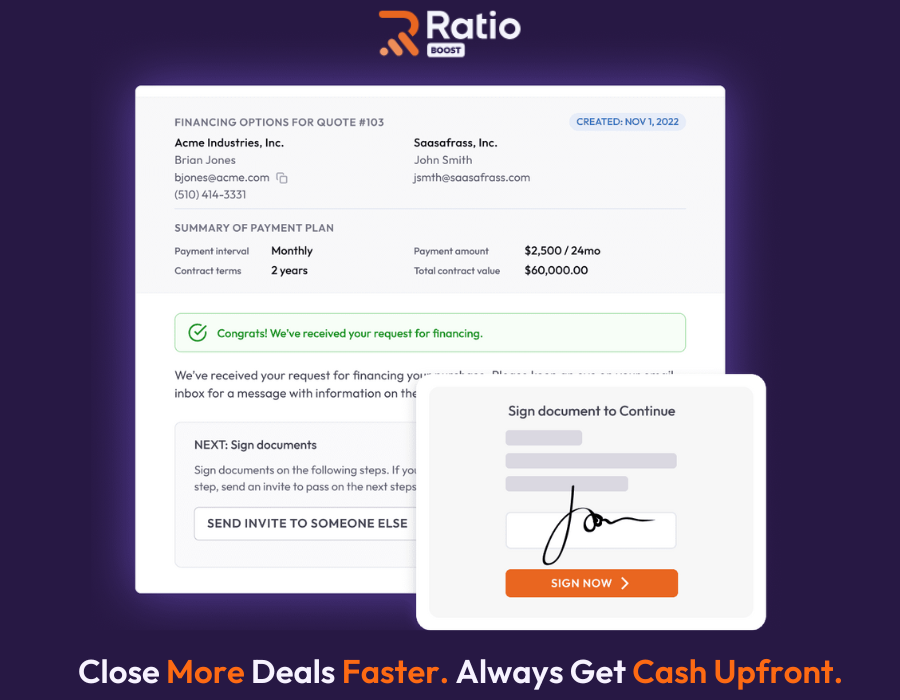
- 🔁 Flexible Mid-Term Upsells & Renewals: Extend terms or add new products mid-cycle without restarting the quoting process or breaking payment continuity.
- ⚙️ Seamless CRM, CPQ & Billing Integration: Native integrations with CRMs, billing, and accounting platforms—like Salesforce, HubSpot, Chargebee, Recurly, QuickBooks, and NetSuite. No rip-and-replace required.
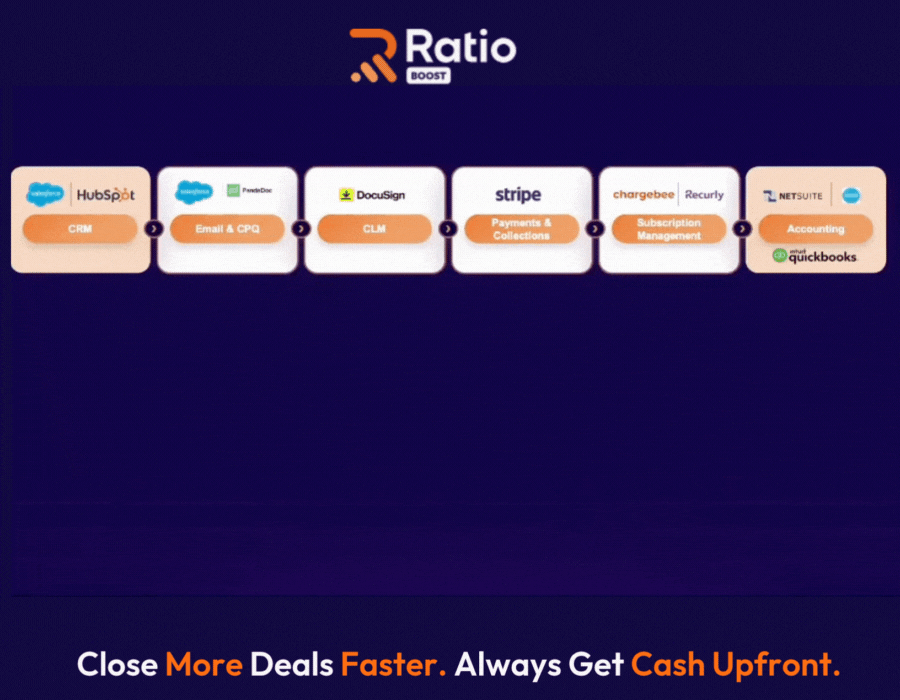
✔️ Ratio Pros
- Upfront cash for sellers on financed deals (minus platform fees)
- Accelerates deal cycles by removing payment friction
- Preserves pricing integrity—no need to give heavy discount for budget-constrained buyers
- Offloads payment risk and collections to Ratio
- Works inside your CRM + billing stack—no rip-and-replace
- Supports growth-stage SaaS with flexible terms and GTM alignment
❌ Ratio Limitations
- Not ideal for non-subscription or hardware-heavy businesses
- Light CPQ logic—may not support very complex, engineering-driven product configurations
🔗 Ratio Integrates With
- CRM: Salesforce, HubSpot
- Subscription Billing: Chargebee, Recurly, NetSuite, Chargify
- Accounting: QuickBooks, Xero, Oracle NetSuite, Sage
- Payments & Banking: Stripe, ACHQ, GoCardless, Plaid
🏆 Ratio is Best For
- SaaS companies closing high-ACV or multi-year deals
Where cash flow timing matters just as much as contract value. - Vendors selling to SMBs or procurement-led enterprises
That demand flexible payment terms—but still expect enterprise-grade execution.
💰 Ratio Pricing
It’s free for sellers. Go ahead and book your demo to see Ratio Boost in action.
2. Cacheflow
Most Q2C tools focus on automating internal workflows. Cacheflow flips the script by turning quoting into a buyer-friendly checkout experience—letting customers choose their plan, sign, and pay in one interactive flow.
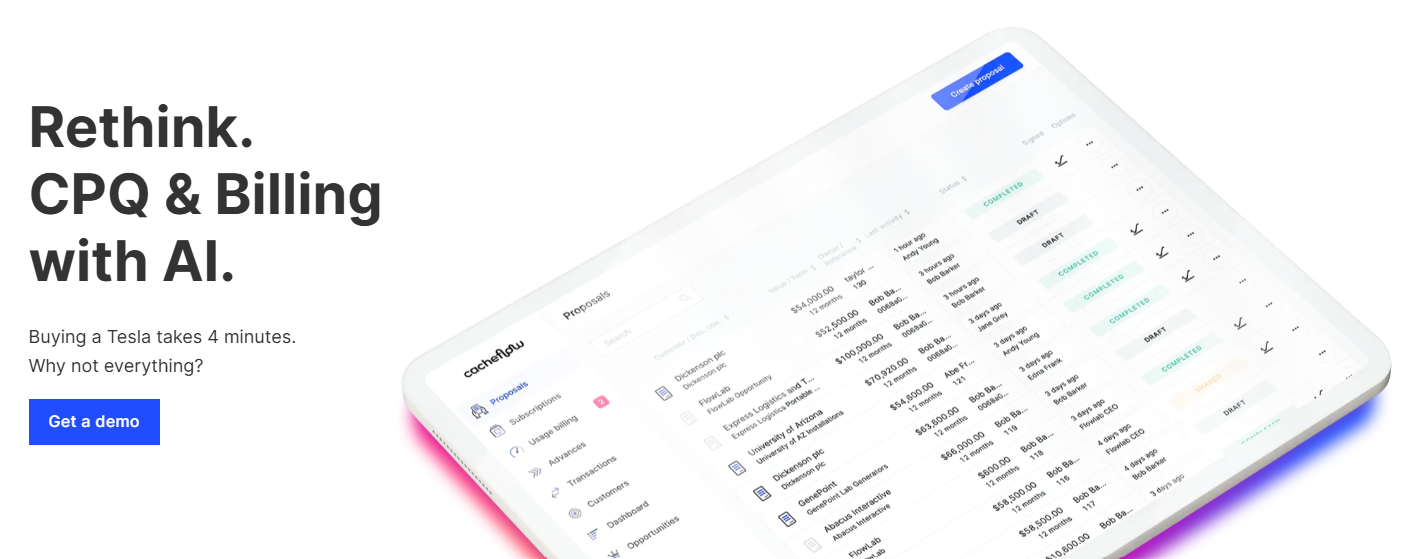
It's purpose-built for SaaS companies that want to speed up deal velocity without sacrificing control over pricing or billing. In fact, according to the latest information, the platform has been acquired by HubSpot through a signed agreement.
Why it ranks #2 for revenue impact:
Cacheflow simplifies and accelerates the quote-to-close journey by embedding approvals, e-signature, and payments into a single branded experience. It’s not just easier for reps—it gives buyers a frictionless path to commit. That means fewer drop-offs, faster closes, and easier renewals.
While it doesn’t offer financing or upfront cash to sellers like Ratio Boost, it does drive faster deal velocity and expansion readiness—especially for teams selling SaaS subscriptions.
🚀 Cacheflow Key Features That Move Revenue
- 🧾 Checkout-Style Quoting: Turn every quote into a self-serve link where buyers can select pricing plans, approve internally, sign digitally, and pay—without back-and-forth emails.
- 🔁 Subscription Billing Built-In: Natively supports usage-based, ramped, and multi-year SaaS contracts. Automates renewals, upgrades, downgrades, and proration.
- 🪄 Custom Pricing & Discount Logic: Handle multi-product, tiered, and hybrid SaaS pricing models without depending on a heavy CPQ setup.
- 🧩 Real-Time Integration with CRM & Finance Stack: Sync quotes, contracts, payments, and subscription terms with Salesforce, HubSpot, Stripe, QuickBooks, and others.
- 📦 All-in-One Buyer Room: Let your customer manage the quote, contract, onboarding, and billing setup in one shared interface—reducing drop-off and legal delays.
✔️ Cacheflow Pros
- Accelerates deal velocity by eliminating handoffs between quoting, approvals, and billing
- Lightweight and ideal for fast-moving SaaS teams
- Offers robust pricing flexibility and native billing—not just quoting
- Streamlines onboarding and subscription setup in one experience
❌ Cacheflow Limitations
- Does not provide seller-side financing or upfront cash (unlike Ratio Boost)
- Lacks deep CPQ logic for highly complex product configurations
- May require customization for non-SaaS or hardware-heavy sales models
🔗 Cacheflow Integrates With
- CRM: Salesforce, HubSpot
- Billing & Payments: Stripe, QuickBooks, NetSuite
- Subscription Management: Chargebee, Recurly
- Others: Zapier, Slack, Google Workspace
🏆 Cacheflow is Best For
- SaaS teams closing mid-sized deals that want to speed up buyer decision-making
- PLG or sales-led motions that benefit from buyer self-serve experiences
💰 Cacheflow Pricing
Cacheflow offers custom pricing based on features and team size. You can request a personalized demo on their official site.
3. DealHub QTC
When SaaS deals get complex with multi-product bundles, approval layers, and legal workflows. Most Q2C tools fall short. DealHub stands out by bringing CPQ, digital deal rooms, contract management, and subscription billing into a single platform. It’s especially strong for teams that need control across the full sales-to-revenue lifecycle.
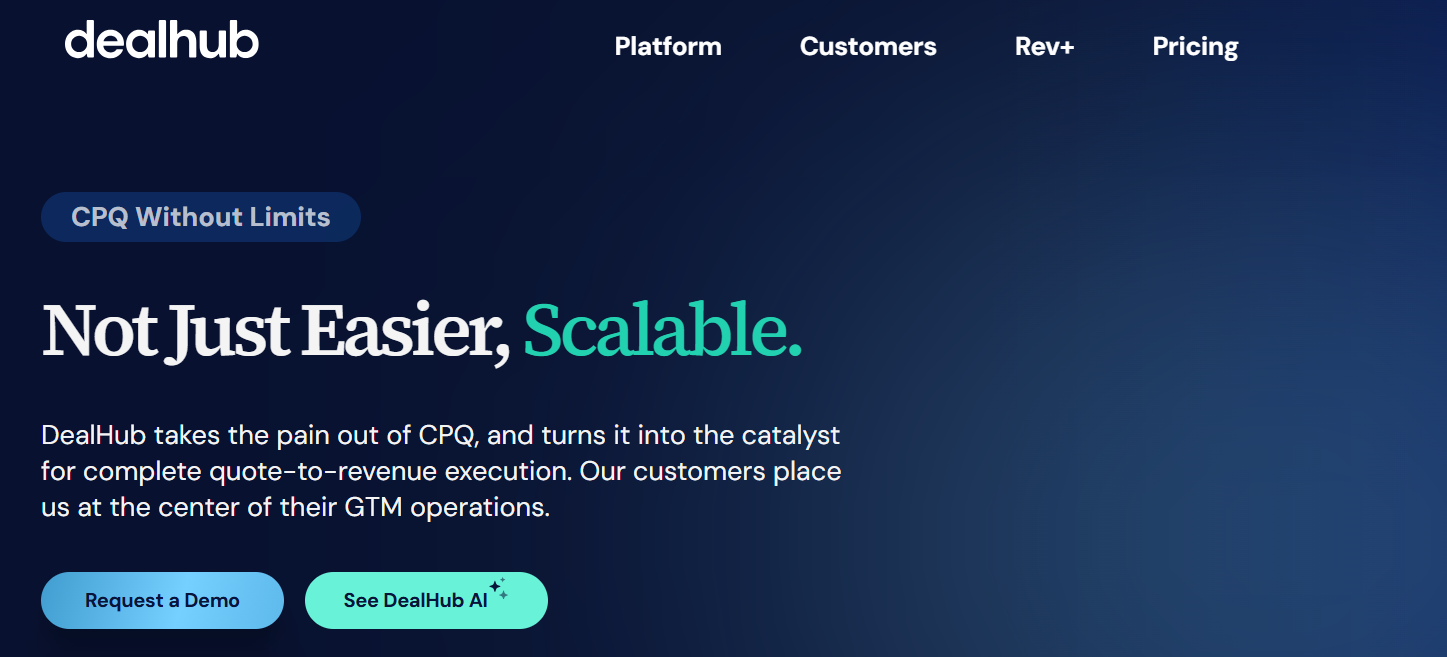
Why it ranks #3 for revenue impact:
DealHub helps sellers standardize and streamline complex quotes, manage approvals, and close faster through interactive buyer experiences.
It doesn’t offer embedded financing like Ratio Boost or checkout-style flows like Cacheflow, but it shines in mid-market to enterprise SaaS sales with configurable deals, long cycles, and multiple stakeholders. Its strength is in operational rigor and visibility across Sales, RevOps, and Finance.
💡 Real-World Impact: WalkMe
WalkMe, a public SaaS company, uses DealHub to accelerate quoting and contract execution across a multi-product portfolio. The platform helped streamline approvals and deal reviews, cutting quote cycles significantly and aligning Sales and Finance workflows.
🚀 DealHub Key Features That Move Revenue
- 🧠 Unified CPQ, CLM & Subscription Management: Create complex quotes, configure approvals, and manage contracts—all inside one platform. No stitching together point solutions.
- 🏢 Digital Deal Rooms (DDRs): Buyers can review pricing, documents, contracts, and eSign—all in a shared workspace with audit trails and real-time visibility.
- 🔁 Subscription & Renewal Management: Built-in tools to manage SaaS renewals, amendments, and upgrades—without depending on a third-party billing tool.
- 📈 Revenue Intelligence Dashboards: Track deal stage, forecast accuracy, pricing trends, and rep behavior across the entire Q2C process.
- 🧩 Bidirectional Salesforce Integration: Deep native sync between DealHub and Salesforce—quotes, approvals, line items, and contracts automatically flow between systems.
✔️ DealHub Pros
- Excellent for mid-to-enterprise SaaS with layered approval processes
- All-in-one QTC system reduces tech stack sprawl
- Strong digital sales room experience improves buyer visibility and control
- Subscription and contract workflows are fully native—no bolt-ons needed
❌ DealHub Limitations
- Steep initial learning curve for administrators, especially non-technical users
- No embedded financing or payment flexibility for buyers
- Heavier implementation cycle compared to lightweight tools like Cacheflow
- May be overkill for early-stage SaaS or PLG models with simple quoting needs
🔗 DealHub Integrates With
- CRM: Salesforce, Microsoft Dynamics
- eSign & CLM: DocuSign, AdobeSign
- CPQ/Billing: Native DealHub billing + integrations with Netsuite, Zuora
- Analytics & RevOps: Snowflake, Gong, Slack
🏆DealHub is Best For
- SaaS companies with large product catalogs or complex pricing
- Teams that need tight collaboration between Sales, Legal, and Finance
- Revenue orgs looking for QTC consolidation under one roof
💰 DealHub Pricing
DealHub offers tiered pricing based on features and team size. You can request a customized quote and demo at dealhub.io.
4. Maxio
Maxio isn’t just a CPQ tool—it’s a full Q2C stack purpose-built for recurring revenue companies. Born from the merger of SaaSOptics and Chargify, Maxio combines subscription billing, revenue recognition, and now CPQ into one platform. It’s particularly strong for SaaS teams that prioritize financial accuracy, compliance, and reporting clarity over sales-led customization.
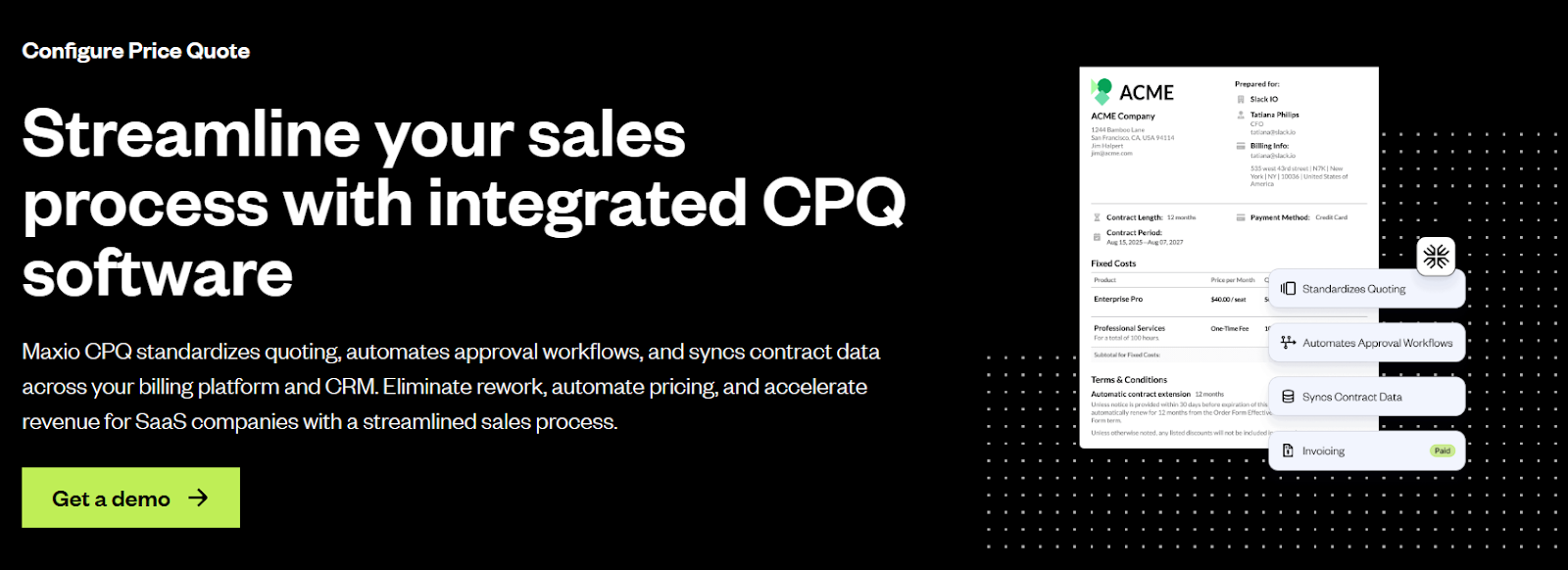
Why it ranks #4 for revenue impact:
Maxio CPQ helps B2B SaaS companies reduce revenue leakage, accelerate quote-to-invoice cycles, and improve cash predictability by embedding billing and rev rec logic directly into the quoting layer.
It doesn’t offer embedded financing like Ratio Boost or buyer-facing checkout flows like Cacheflow, but it delivers unmatched control over quote integrity, ASC 606 compliance, and financial reporting. Its strength lies in serving finance-led SaaS teams scaling ARR while maintaining audit-ready processes.
🚀 Maxio Key Features That Move Revenue
- 🔁 Multi-Model Pricing Support: Supports usage-based, tiered, ramp, flat-fee, milestone-based, and hybrid billing models—all from one quote engine.
- ⚙️ Finance-Controlled CPQ Rules: Finance can set pricing, discounting, and term logic to protect margin and reduce non-compliant bookings.
- 📊 ASC 606 / IFRS 15 Revenue Recognition: Audit-ready revenue schedules ensure every contract aligns with financial standards from Day 1.
- 💸 Integrated Invoicing & Collections: Quotes flow into automated billing and collection tools—ensuring what’s sold gets paid.
- 🧾 One System for Billing, CPQ & Reporting: Removes reconciliation friction between CPQ, billing, and reporting platforms—everything stays aligned.
- 📈 Advanced SaaS Metrics Tracking: Out-of-the-box dashboards track MRR, churn, cash vs. revenue, and renewal forecasts across cohorts and segments.
✔️ Maxio Pros
- Designed for finance-first teams in B2B SaaS
- Fully integrated revenue recognition and billing
- Strong audit readiness and compliance
- Handles complex usage and hybrid pricing
❌ Maxio Limitations
- No embedded financing or buyer-side checkout UX
- More rigid setup than lightweight Q2C tools like Salesbricks
- Requires moderate implementation effort, especially for custom billing logic
🔗 Maxio Integrates With
- CRM: Salesforce, HubSpot
- Billing & Accounting: QuickBooks, NetSuite, Xero, Sage
- Analytics: Looker, ChartMogul, Baremetrics
🏆 Maxio is Best For
SaaS companies scaling to $5M–$50M ARR with Finance-led operations
Teams seeking strict revenue compliance and integrated quote-to-cash workflows with visibility and control
💰 Pricing
Pricing is custom-based on company size and complexity. Contact Maxio for a quote.
5. Salesbricks
Salesbricks is designed to simplify the quote-to-revenue process for SaaS teams. It offers a unified experience for quoting, contract execution, billing, and revenue tracking—delivered via a highly intuitive interface.
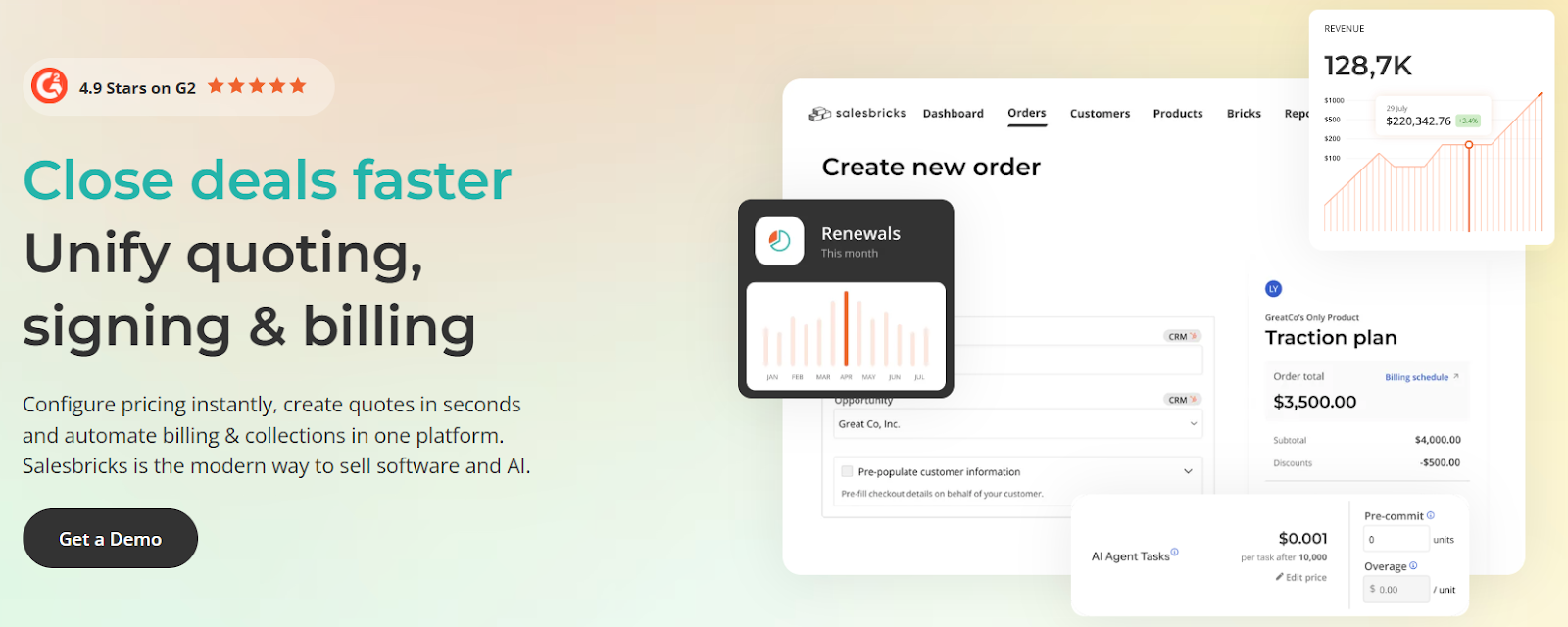
Built around ease-of-use, it’s especially well-suited for early-stage SaaS founders and PLG/sales-led hybrid teams.
Why It Ranks #5 for Revenue Impact
Salesbricks accelerates deal velocity by eliminating complexity from quoting and checkout—but without embedded financing or deep finance-driven architecture. Its simplicity enables lean ops to scale faster and reduce quoting friction, making it ideal for SMB and startup-focused teams.
💡 Real-World Signal
Salesbricks was ranked by G2 as the #1 easiest-to-use quote-to-cash software, with strong user satisfaction around rapid sales onboarding and simplified revenue workflow automation.
🚀 Key Features That Move Revenue
- 🧩 Modular Q2C Stack for Fast-Moving SaaS Teams: Salesbricks combines quoting, contracting, and billing into a single lightweight platform.
- 🧾 Checkout-Style Quote Pages: Reps can send links with interactive pricing, terms, and signature collection. Mirrors the frictionless experience of a B2C checkout for faster buyer decisions.
- 📈 Recurring Revenue & Billing Automation: Automates invoicing, renewals, mid-cycle upgrades, and usage tracking.
- 📊 Live Revenue Analytics Built-In: Dashboards track bookings, ARR, churn, and renewals in real time without needing separate BI tooling or heavy RevOps lift.
- 💬 Self-Serve Onboarding for Reps: New users can be onboarded in under 1 hour. No technical teams or multi-week training cycles required.
✔️ Pros
- Fast deployment and easy onboarding—as few as days to go live
- Enables a B2C-like SaaS buying experience to reduce deal friction
- Feeds clean revenue data directly into finance systems—reducing manual reconciliation
- Ideal for teams operating without a dedicated RevOps or finance infrastructure
❌ Limitations
- Lacks embedded seller-side financing or upfront payouts
- May not support complex, multi-tiered enterprise pricing or audit workflows
- Future scalability might be a concern for highly regulated or complex revenue models
🔗 Integrates With
- CRMs: Salesforce and HubSpot
- Billing Systems: Stripe, QuickBooks, Xero
- Communication: Gmail, Slack
- Proposal & Payments: Native checkout flow, PDF exports, contract templates
📌 Best For
- SaaS startups and SMBs selling subscription-based or PLG-led offerings
- Companies with lean sales operations looking to reduce quoting and billing friction
- Teams that value a fast, B2C-like user experience while preserving simple reporting workflows
💰 Pricing
Salesbricks pricing is transparent and tiered: starting at $500/month for up to 5 users and up to $1,500/month for high-volume plans, with a fee per transaction volume beyond set limits. Custom enterprise packages are available.
We’ve ranked every Q2C software in this list through one lens: how well it converts deals into actual revenue.
Some tools help you quote faster. Others improve approvals or billing automation.
But only one, i.e., Ratio Boost, completes the quote-to-cash journey with upfront payment, flexible buyer terms, and no added risk to you.
Let’s see what’s more, making it the best bet for you.
Why Ratio Boost Is the Best Quote-to-Cash Software to Power Revenue in 2025
Most Q2C platforms promise process automation. Ratio Boost delivers something more: cash acceleration, buyer flexibility, and revenue intelligence; all in one platform.
If your goal is to turn the pipeline into upfront, predictable revenue—without adding friction, delays, or operational debt—Ratio Boost is your revenue co-pilot.
Here’s what sets it apart:
🔹 Capital That Scales With You
With a $411 million funding pool, Ratio can finance as many contracts as your team closes. There’s no ceiling on your ability to turn bookings into banked revenue—whether you’re closing 10 or 10,000 deals.
🔹 Procurement-Ready for Faster Yes
Every quote includes embedded payment options and pre-approved terms—so procurement can say yes without redlines, legal delays, or extra paperwork.
🔹 Enterprise-Grade Compliance, CFO-Approved
SOC 2, PCI-DSS, KYC, and AML-compliant. All financing is off-balance-sheet and revenue-aligned—giving Finance confidence and flexibility.
That’s why teams like Bigtincan trust Ratio Boost to close more deals faster, and convert pipeline into predictable revenue without discounting, delays, or collection risk.
"Ratio is helping us transform the purchasing experience. We see many ways to sell more deals faster—by speeding up procurement for our customers. And we collect upfront, no matter how the customer pays."
— David Keane, Founder & CEO @ Bigtincan
Ready to accelerate revenue without sacrificing flexibility or cash flow? Request a demo and see how Ratio Boost powers faster closes, stronger margins, and real cash in hand.
Disclaimer: All insights in this post are based on publicly available data, vendor websites, and user reviews as of our latest research. While we've prioritized accuracy and relevance for B2B SaaS decision-makers, we recommend validating features, pricing, and fit through vendor demos and tailored consultations before making a final selection.
Have more questions? Explore our FAQs.
1. Why Does Faster Quoting Still Lead to Slow Revenue Collection?
Because quoting is only the first half of the journey. Without embedded collections, flexible payments, and capital backing, Q2C stalls at “sent.”
Ratio Boost fixes that by turning every quote into a revenue-ready, finance-approved, buyer-flexible contract—paid in full upfront.
2. Is It Risky to Automate Buyer Payment Plans in the Q2C Process?
Not when underwriting is built-in. Blind flexibility creates AR drag. But real-time risk scoring (like Ratio Boost offers) means only qualified buyers see term offers—and you still get paid upfront.
3. When Does It Make Sense to Replace Your CPQ with a Full Quote-to-Cash Platform?
When quoting becomes just one part of your bottleneck. If you’re offering flexible terms, chasing payments post-close, or syncing data across CPQ, billing, and collections tools manually—it's time to rethink the stack.
Ratio Boost replaces fragmented quoting + collections + financing workflows with a unified Q2C layer. You send a quote, your buyer gets term options, and you get paid upfront—no handoffs, no manual syncs.







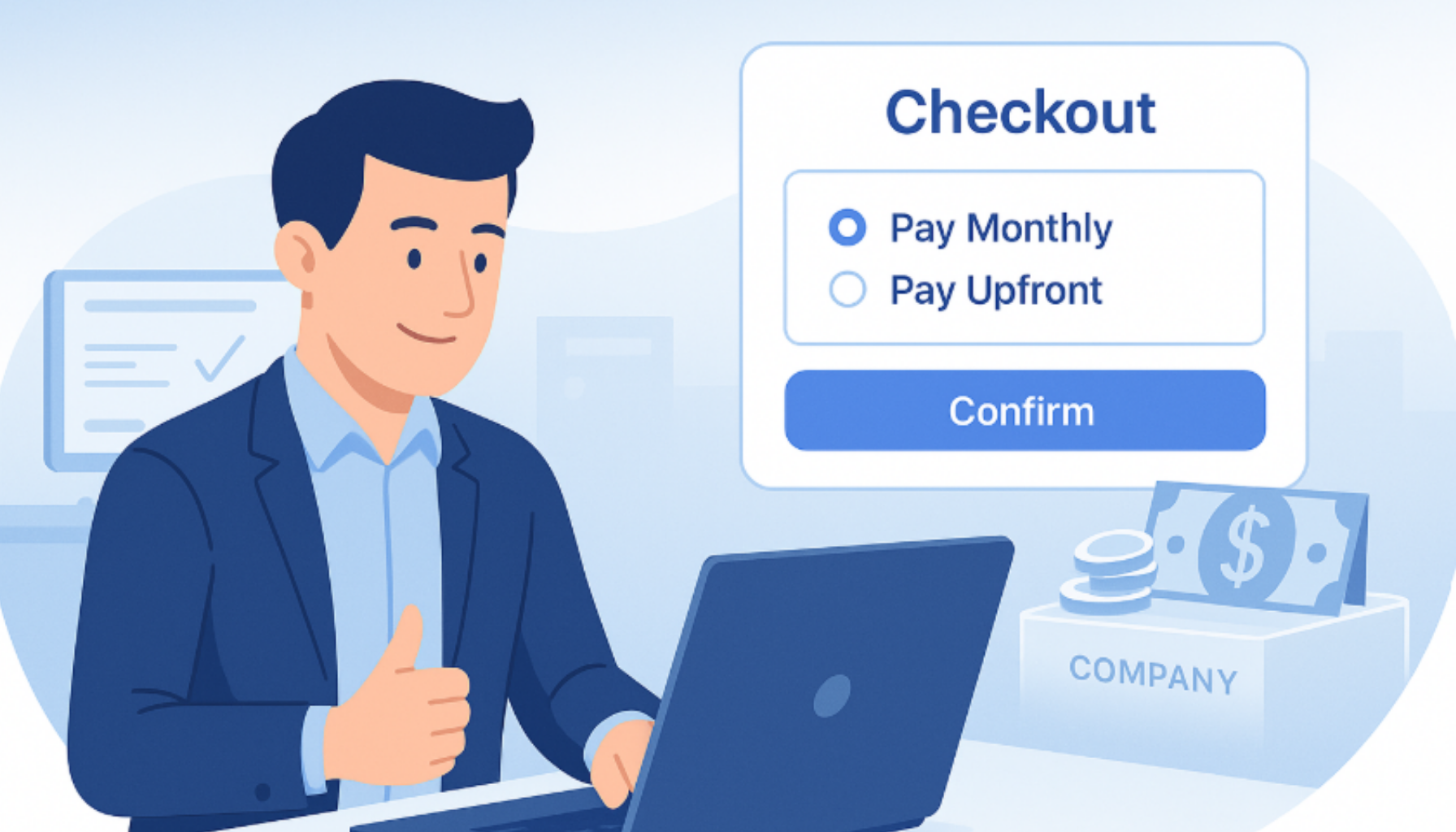
.png)



